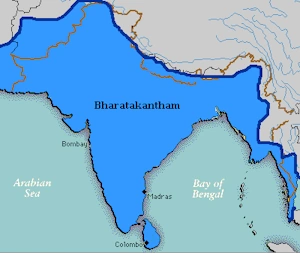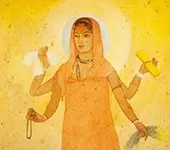There Is Agniloka, Vayuloka, and Indraloka on the Surface of Earth Also

We have already seen this concept:
The three worlds that the Vedas speak about exist at three levels. One as earth – atmosphere – heaven. Heaven means Swargaloka or sky.
The same triad exists in the human body as the abdominal cavity, chest cavity, and skull cavity.
On the surface of the earth, from the Indian Ocean to the Himalayas, is Bhuloka. This is roughly from the equator to the north longitude of 32 degrees. This is also called Agniloka.
The Himalayas spread over a significant number of latitudes. Here, when we say 32 degrees north, it refers to the region from the equator to where Lahaul and Spiti are located in the Himalayas. These places are in Himachal Pradesh, along that longitude. Up to that longitude is Bhuloka, also called Agniloka or Manushyaloka.
Do not think this is just the present India. We are so accustomed to seeing the current political map of India with Pakistan as the boundary on the west. Originally, it was not like this. To the west, it spread up to Iran, which is called Parastan. Agniloka consisted of Hindustan and Parastan.
It has another connection. It is with Agni that yajnas are performed. Why is yajna performed? To attain Swarga. Unextinguished Agni can be maintained, and yajnas such as Agnihotra can be performed year-round only to the south of the Himalayas due to the favorable climate. North of the Himalayas, this may not be possible due to extreme weather conditions. This is also a reason, geographically, why Bharata is said to be the only Karmabhumi.
From 32 degrees north to 45 degrees north is Antarikshaloka.
At this altitude lies Mongolia. This is also called Vayuloka. Basically, from Lahaul-Spiti to Mongolia is Vayuloka. North of this is the Indraloka on earth, which extends to the North Sea, around 56 degrees north latitude.
Essentially, we are referring to the Asian continent here. You must have understood.
Bhumi, Antariksha, and Swarga all exist in Asia. This does not mean that there is no Swarga in the sky. Consider the reflection of the sun in water in a pot. That does not mean there is no sun in the sky. If an eclipse happens to the sun in the sky, it can also be seen in its reflection in the water.
So, Vedic concepts apply on different planes or all these planes. Whatever happens in Swarga also happens here on earth, particularly in Asia—in Siberia, which is referred to as Swarga. Not the present Siberia. Siberia used to be quite different earlier. It was like a real heaven. We will see this later.
Whatever happens in the sky or Swarga also happens in our mind, in our thoughts, and in our brain.
What is Meru Parvata? In the scriptures, Meru—the golden mountain—is mentioned as the center of Jambu Dwipa. Meru is, in fact, the Pamir mountains. Even the locals, in the Wakhi language, call it Bam-i-Duniah, meaning ‘the roof of the world.’
No wonder the people of Parastan were also aware of the structure of the world. Northwest of Bharatavarsha is Ilavrita Varsha. Meru is in the middle of that.
The shape of Ilavrita is described in the Puranas as that of a bow, encompassing Meru.
Geologically, Pamir refers to the U-shaped valley, as indicated by the shape of Ilavrita. So, Ilavrita Varsha is to the north and northwest of Bharatavarsha. Meru is in Ilavrita Varsha.
Who are the neighbors of Ilavrita Varsha?
- Harivarsha, which is present-day Afghanistan.
- Ketumala Varsha is Turkmenistan.
- Ramyaka Varsha is Uzbekistan.
- Hiranya Varsha is Kyrgyzstan.
- Kuruvarsha is Kazakhstan.
- Bhadrashwa Varsha is Xinjiang and Uighur areas of China.
The Puranas talk about other mountains around Meru.
Geologically, Pamir is at the junction of the Himalayas with the Tian Shan, Karakoram, Kunlun, Hindu Kush, and Hindu Raj ranges. It is called the Pamir Knot, quite similar to the description in the Puranas.
This short discourse is not exhaustive. I am just trying to make these connections visible to you so that we can explore the Vedas themselves to understand the ancient history of Bharata.
For this, you must primarily understand this concept:
Bhumi – Antariksha – Swarga, or Agniloka – Vayuloka – Indraloka, the triad as found in the Vedas, also has an equivalent on the surface of the earth as the Asian continent.
- From the Indian Ocean to the Himalayas is Agniloka.
- From the Himalayas to Mongolia is Vayuloka.
- From Mongolia to the North Sea is Indraloka.

English
Bharat Matha
Click on any topic to open
- 44 The Greatness of Hindu Family Life
- 43 Ethical Warfare in Ancient Hindu Tradition
- 42 Agnikula: The Fire Lineage of Rajputs
- 41 Longevity of Our Ancients
- 40 Brahmacharya Stage of Life in Ancient Bharat
- 39 Alwar City and Mahabharata
- 38 Zoroastrianism: An Offshoot of the Vedic Religion
- 37 Origin of the Terms, Hindu and Hindustan
- 36 Vedic and Zoroastrian Religions: A Role Reversal
- 35 Harappa was Hariyupiya: Rigveda Refutes Aryan Migration Theory
- 34 Descendants of Lord Rama and Yudhishthira: Royal Legacies in History
- 33 The Revolutionary Legacy of Abhinav Bharat: A Comprehensive Look
- 32 Geography in Mahabharata
- 31 Seven Ancient Kingdoms to the West of Sindhu
- 30 Guru Ram Singh - A Hero Of Indian Freedom Movement
- 29 Bharata Varsha = Indian Peninsula + Eight Islands. Which Are They?
- 28 The Puranic Geography Of Bharata Varsha
- 27 Many Rishis Consider Indra and Varuna as Equals
- 26 Devasura Battle At Balkh
- 25 Vrishakapi the Asura Chief
- 24 The History of Alcohol
- 23 Founding of the Asura Religion
- 22 Bharata Varsha Gets Divided Into Two Parts
- 21 How Siberia Lost Its Status as Swarga on Earth
- 20 How Did Bharata Varsha Get Its Name?
- 19 We Should Build Temples for Bharat Mata and Worship Her
- 18 There Is Brahmaloka and Vishnuloka on the Surface of Earth Also
- 17 There Is Agniloka, Vayuloka, and Indraloka on the Surface of Earth Also
- 16 What Is the Role of Religion in a Secular Nation?
- 15 Lesser Known Facts About Jhansi Rani - Part 3
- 14 Lesser Known Facts About Jhansi Rani - Part 2
- 13 Lesser Known Facts About Jhansi Rani - Part 1
- 12 The Childhood of Sardar Patel
- 11 What Exactly is Jamboo Dwipa?
- 10 Actions in Bharata Varsha Alone Earn Punya and Papa
- 9 How Pilgrimages Held Bharata Together as a Single Nation
- 8 Rigveda on Seven Punya Nadis of Hindustan
- 7 How Rivers Helped in Keeping India as a Single Unit
- 6 Natural Abundance Shaped India's Thought Process
- 5 Importance of Prayag
- 4 Revisiting Education through the Lens of Sanatana Dharma
- 3 God Is Love, Said Tamil Saint Thirumular
- 2 Why All Avataras Happened in India Only?
- 1 Our Culture Is Strong Because It Is Based On Eternal Truth
7
30
Astrology
Atharva Sheersha
Bhagavad Gita
Bhagavatam
Bharat Matha
Devi
Devi Mahatmyam
Ganapathy
Glory of Venkatesha
Hanuman
Kathopanishad
Mahabharatam
Mantra Shastra
Mystique
Practical Wisdom
Purana Stories
Radhe Radhe
Ramayana
Rare Topics
Rituals
Rudram Explained
Sages and Saints
Shiva
Spiritual books
Sri Suktam
Story of Sri Yantra
Temples
Vedas
Vishnu Sahasranama
Yoga Vasishta